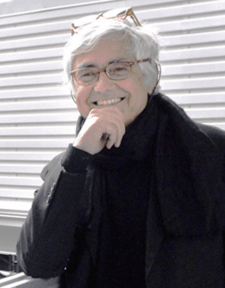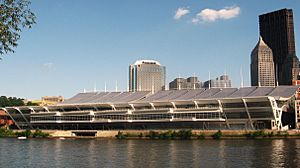Rafael Viñoly facts for kids
Quick facts for kids
Rafael Viñoly Beceiro
|
|
|---|---|

Rafael Viñoly
|
|
| Born | 1 June 1944 Montevideo, Uruguay
|
| Died | 2 March 2023 (aged 78) New York City, New York, U.S.
|
| Alma mater | University of Buenos Aires |
| Occupation | Architect |
| Awards | International Fellow, The Royal Institute of British Architects (2007), Medal of Honor, American Institute of Architects, New York Chapter (1995), National Academician, The National Academy (1994) |
| Practice | Rafael Viñoly Architects PC |
| Buildings | Brooklyn Children's Museum Tokyo International Forum The Kimmel Center for the Performing Arts Cleveland Museum of Art David L. Lawrence Convention Center Howard Hughes Medical Institute Janelia Farm Research Campus Bronx County Hall of Justice Carrasco International Airport 432 Park Avenue 20 Fenchurch Street NEMA (Chicago) |
Rafael Viñoly Beceiro (1 June 1944 – 2 March 2023) was an Uruguayan-born architect based in New York. He was the principal of Rafael Viñoly Architects, which he founded in 1983. The firm has offices in New York City, Palo Alto, London, Manchester, Abu Dhabi, and Buenos Aires. Viñoly designed landmark buildings internationally.
Viñoly rose to international prominence with his Tokyo International Forum. Reviewing the Museum of Modern Art's exhibition of models and drawings for the building while it was still under construction, the then New York Times architecture critic Herbert Muschamp hailed Viñoly's design as "a monument to the idea of openness" that "revives faith in architecture as an instrument of intellectual clarity".
Contents
Early life
Viñoly was born in Montevideo, Uruguay, on 1 June 1944, to Román Viñoly Barreto, a film and theater director, and Maria Beceiro, a math teacher. "It was a cultivated household where the architecture of Le Corbusier, the art of translation, or the conducting of Arturo Toscanini might form part of the table talk," wrote Louis Jebb, in The Art Newspaper. "The family moved to Buenos Aires when Rafael was five years old, after his father was invited to the city to direct Wagner's music drama Die Walküre at the city's Teatro Colón. Viñoly attended the University of Buenos Aires, receiving a Diploma in Architecture (1968) and a Master of Architecture (1969) from the Faculty of Architecture and Urbanism.
Career
In 1964, he formed the "Estudio de Arquitectura Manteola-Petchersky-Sánchez Gómez-Santos-Solsona-Viñoly" architectural firm in Buenos Aires with six associates (Flora Manteola, Ignacio Petchersky, Javier Sánchez Gómez, Josefina Santos, and Justo Solsona). This practice, which came to be known as M/SG/S/S/S, or MSGSSS, would go on to become one of the largest architectural practices in South America, completing many significant commissions in a very short time.
In 1978, Viñoly and his family relocated to the United States. For a brief period, he served as a guest lecturer at the Harvard Graduate School of Design. In 1979, he settled permanently in New York City where, in 1983, he founded the firm Rafael Viñoly Architects PC. His first major project in New York was the John Jay College of Criminal Justice, completed in 1988. In 1989, he won an international competition to design the Tokyo International Forum, which was completed in 1996. His firm's design was one of the finalists in the World Trade Center design competition.
During the course of his 40-plus year career, Viñoly practiced in the United States, Latin America, Europe, Asia, Africa, and the Middle East.
Viñoly earned a reputation as "a serene functionalist and a master of institutional design", as an unbylined article in Metropolis put it, noting that "schools, civic buildings, convention centers, and the like have long been the mainstay of Viñoly's practice." "I'm very interested in unglamorousness!" he said, in the same article. "People don't understand how important this kind of thing" – the human use of buildings, as opposed to architecture as monumental sculpture – "is. If you remember, 10, 15 years ago, if you weren't working on a museum you weren't an architect. With hospitals, that level of snobbism would never have been applicable—nobody gives a royal screw about that stuff". John Gravois, writing in the UAE National News, applauded Viñoly's "affinity for the nerdy, workmanlike challenges of designing complex institutional architecture: hospitals, a nanosystems institute, a cancer research center. His buildings often seem designed not to be photographed from the air but to be used and experienced – from both the inside and out. And he displays the distinctly unstar-like habit of designing structures that respect their neighbors." As well, Gravois observed, he deplores "the insidiousness of contemporary architectural culture", singling out for criticism buildings "that tend to do only one thing, which is to create the sense of fame".
Viñoly was a Fellow of the American Institute of Architects, an International Fellow of the Royal Institute of British Architects, and a member of the Japan Institute of Architects and the Argentinian Sociedad Central de Arquitectos.
Personal life
Viñoly was married to the interior designer Diana Viñoly, whose aesthetic sensibility he once described as "mixed and unorthodox but never busy. There is a narrative to the objects she selects and each house is like a living thing. Nothing's ever composed, static, or finished. ... How she does it I don't know."
Their son, Román Viñoly, is the director of Rafael Viñoly Architects. Viñoly also had two stepsons, Nicolas and Lucas Michael.
The family lived in multiple locations: Tribeca, New York; Water Mill, Long Island (where Viñoly built a piano house for his collection of nine concert grand pianos); and London.
He also "remained connected to his home country, spending summers in Montevideo, and designing there as well," wrote Elizabeth Fazzare, in an obituary for Architectural Digest. "One of his most handsome recent projects is the Laguna Garzón Bridge, a circular road deck and pedestrian walkway whose design allows an eco-friendly crossing over the environmentally sensitive 4,448-acre lagoon on the nation's coast."
Death and legacy
Viñoly died from an aneurysm in New York City on 2 March 2023. He was 78.
Major works
Major works by Viñoly include 432 Park Avenue in Manhattan, 20 Fenchurch Street in London, the Curve Theatre Leicester, and Firstsite art gallery in Colchester, Essex.
Argentina (1968–1979)
- Chamber of Deputies (House of Representatives, or Edificio Anexo de la Cámara de Diputados), Buenos Aires (1966)
- UIA (Designed 1968; completed 1974)
- Banco Ciudad de Buenos Aires (1968)
- Rioja Housing Project (1969)
- CASFPI (Caja de Ayuda y Subsidios Familiares para el Personal de la Industria, "Industrial Workers' Mutual Assistance and Family Subsidies Fund") Headquarters (1974)
- Barrio ALUAR (Aluminio de Argentina) Factory Housing (1974)
- Mendoza Stadium (1978)
- ATC (Argentina Televisora Color) (1978)
United States and abroad (1980–2023)
- John Jay College of Criminal Justice, New York City (1986–88)
- Lehman College, APEX (Athletics and Physical Education Facility), Lehman College, The Bronx, New York City (1987–94)
- Tokyo International Forum, Tokyo, Japan (1989–96)
- Bronx County Hall of Justice (1994–2006)
- Princeton University Stadium (Powers Field) (1995–1998)
- Van Andel Institute(Phases 1 and 2, 1997–2009)
- Kimmel Center for the Performing Arts (1997–2001)
- David L. Lawrence Convention Center (1999–2003)
- Princeton University, Carl Icahn Laboratory, Lewis-Sigler Institute for Integrative Genomics (LSI) (1999–2004)
- University of Chicago Booth School of Business, Charles M. Harper Center (2000–2004)
- Brooklyn Children's Museum (2001–2008)
- Cleveland Museum of Art (2001–2012)
- Howard Hughes Medical Institute Janelia Farm Research Campus (2002–2006)
- Curve Theatre, Leicester, England (2002–2008)
- Carrasco International Airport, Montevideo, Uruguay (2004-2008)
- 20 Fenchurch Street, London (2004-2014)
- University of Oxford, Radcliffe Observatory Quarter and Andrew Wiles Mathematical Institute (2005-2013)
- The Bryanston, Marble Arch Place, Hyde Park, London (2011-2020)
- Penn Medicine Complex (2007-2015)
- Stanford University Hospital (2007-2019)
- Battersea Power Station Masterplan (2007-2020)
- Edward M. Kennedy Institute for the United States Senate (2010-2015)
Quotations
- "Today we are all under the pervasive influence of fantastic image-making. There is a lot of vanity associated with architecture in this setting, and this is something about which I feel very dubious. There is much confusion about this question of the autonomy of architecture as an artistic practice. Aesthetics and self-expression in architecture are not as important as the fact that it is a social act. There is an enormous social responsibility in what architects do. It is important to push beyond the obvious in order to make something more than what is required. ... [M]echanisms must be sought which ensure the proposal can be enriched and transformed into something which has cultural meaning and which contributes to the sense of permanence and the betterment of the city."
- "If you want to see great architecture, you must go to Fort Worth to see [Louis Kahn's] Kimbell Art Museum. We all have seen it. We have pictures of it. We know it through models and everything, but when you come into this place, the experience has nothing to do with what you see. It is about what you feel, and that is what makes great architecture – the subtleties."
Honors and awards
- Design Honor, Salvadori Center, 2007
- International Fellow, The Royal Institute of British Architects, 2006
- National Design Award Finalist, Cooper-Hewitt National Design Museum, 2004
- Neutra Medal for Professional Excellence: In recognition for his contributions to the Environmental Design Profession and in honor of Modernist architect Richard Neutra, 2000.
- Honorary Doctorate, University of Maryland, 1997
- Medal of Honor, American Institute of Architects, New York City Chapter, 1995
- National Academician, The National Academy of Design, 1994
- Fellow, American Institute of Architects, 1993
- Konex Award, Konex Foundation, Argentina, 1992
See also
 In Spanish: Rafael Viñoly para niños
In Spanish: Rafael Viñoly para niños



